It’s the end of our big summer trip, so I will try to summarize our four-day stay in London, Howard’s first visit here and my first since 1983.
After dealing with a torn suitcase at Heathrow—British Air was quite nice and gave us a replacement suitcase for the time being, we took the tube (subway) to our hotel near Victoria Station, the Cherry Court Hotel, http://www.cherrycourthotel.co.uk, which we found through Rick Steeves London book. When we made reservations over 2 months ago, all doubles (55 pounds a night) were already taken, so we ended up with a triple. The location is great. The rooms are simple but adequate, with firm beds, a color TV, a fruit basket with cereal bars daily, and Internet access. We walked everywhere daily, except for one subway trip to the British Library.
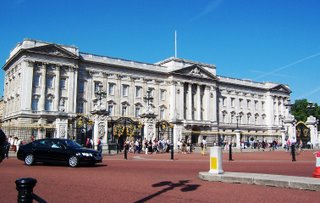

Buckingham Palace Dina, Buckingham Palace, Statue of Queen Victoria
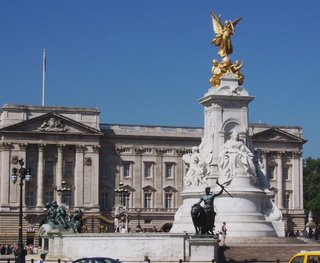 Close up of statue of Queen Victoria
Close up of statue of Queen VictoriaOur first morning here we walked past Buckingham Palace, down the Mall by St. James Park (it is closed to cars on Sundays so should be a great place to stroll then), on to Trafalgar Square.
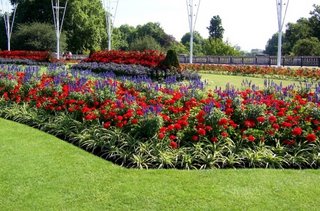

The Mall and part of St. James Park
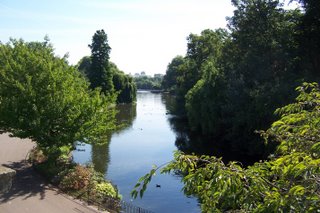 a part of St James' Park
a part of St James' Park 
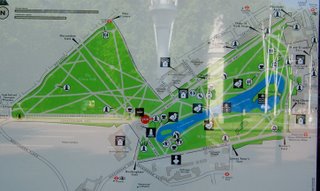
 Flowers in the park
Flowers in the park Nelso
Nelso n
nNelson's Statue at Trafalgar Square
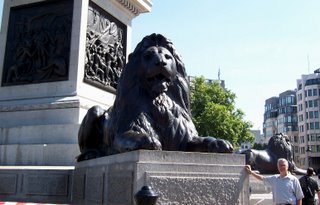 Lion at base of Nelson's statue--see Howard at side to get an idea of the size of it all.
Lion at base of Nelson's statue--see Howard at side to get an idea of the size of it all.We were heading to the National Gallery of Art followed by the National Portrait Gallery. Both are free but ask for donations of at least 2 pounds, and both prohibit photography, even without flash. We both enjoyed both museums.
When we walked down the road, I was amazed by the taxis--most were of a similar style (the older ones with forward bumpers sticking out). Most of the cabs were used for advertisements, many painted in brilliant colors including vibrant pinks and oranges. Also, since central London is such a touristy area, to protect tourists from outside of Great Britain who are not used to cars driving on the left, at intersections were signs painted in the road saying, "Look left," or "look right."

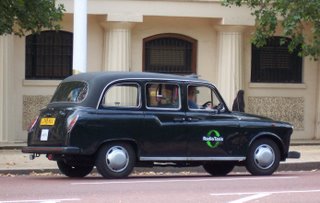
We didn't ever ride in the taxis--just took pics of them. The one on the right is older...with the bumper I was talking about.
For details on the National Gallery, which has paintings from 1250 to the present, go to http://www.nationalgallery.org.uk/collection/default.htm. Howard was delighted to see three Holbein, including his favorite that day of Erasmus.
Some impressive paintings included Van Eyck’s The Arnolfini Marriage (1434), Botticelli’s Venus and Mars (1485) , Titian’s Bacchus and Ariadne (1523), Tintoretto’s The Origin of the Milky Way (1575), several Vermeers, 2 Rembrandt self-portraits (one of which was done early in his career), several Turners, an amazing picture of the execution of Lady Jane Grey, and a really nice Monet bridge painting. Van Gogh’s Sunflowers (one of 6 he did) was not in circulation.
The National Portrait Gallery was amazing too, with portraits actually beginning with Henry VIII. Howard said that though he was overweight (over 400 lb at death), he liked the ways his legs looked so always made sure they were highlighted.
Elizabeth I
There are portraits of those that following him, including Edward VI, at least 3 on display of Elizabeth, 1, one of her presumed lover Dudley, and some of her 2 closest advisors including Francis Walsingham (who started the first secret service system for England). Elizabeth never bathed and was forever powdering her face...so it looked very white. We also saw one of 2 existing portraits of Shakespeare and Howard reviewed British history with me as we saw portraits of James I, several Charles and Georges. I reviewed the story of Lord Nelson and Trafalgar (he was a very small-statured man), and saw a great picture of Charles Darwn.
We skipped the 20th century portraits, and left to try our first pub, walking down the Thames and seeing the action on the river. Howard talked to a fisherman and found out that he was trying to catch eels, that the river was quite salty here but also very clean with lots of fish in it.
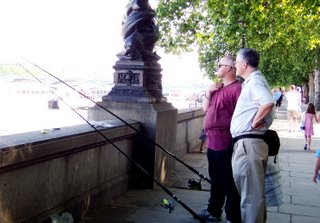
The following is a picture of a pedestrian bridge on both sides of a RR bridge, near the Westminster pier.
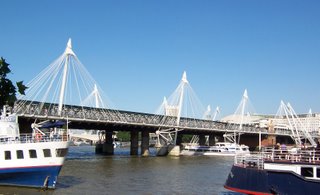
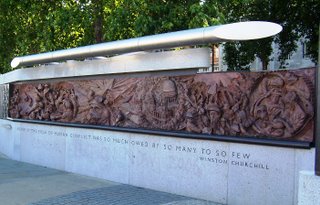
On the right, a memorial to the Battle of Britain....along side the Thames.
We dined at the the Jugged Hare where we both had pies, Howard a steak and ale one and mine was vegetarian. The place was recommended by Rick Steeves as having more veggies, and we both enjoyed the broccoli and parsnips. It also had great Fuller’s Discovery Ale (pale) on tap. At pubs, one picks a table, chooses the food to order, and then goes to the bar to order, giving the table # where the food is to be delivered. Most meals were between six and nine pounds there and quite filling.
http://www.beerintheevening.com/pubs/s/18/188/Jugged_Hare/Pimlico
Tuesday we walked back to the Thames, by Westminister, and caught a catamaran-style riverboat to Greenwich.

During the hour trip, a crew members explained the sights along the way. We got the history of at least seven bridges we passed under including the latest Millenium foot bridge that had to be closed two days after it opened as it swayed with the weight of thousands of people on it. A year later it reopened, much more stable. We saw the London Eye (a British Air business) across the river, a constantly moving extremely tall ferris wheel, from where one can get a great view of London on a clear day. Rotation takes 30 minutes and the cost is 13 pounds, up from 5 just a bit over 5 years ago.
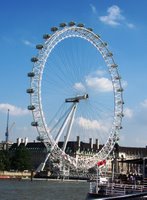
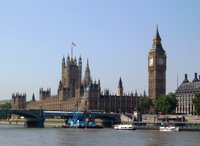 Parliament from the river
Parliament from the river
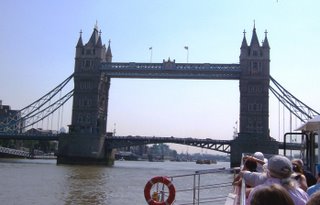
Above: Tower of London w/Traitor's Gate and then Tower Bridge
The river used to be full of commerce with many wharves along the way. Commerce now gets dropped off many miles before London, so the storage buildings have not been turned into luxury apartments. We passed by the Tower of London, a hideous tall glass building, a recreation of Shakespeare's Globe Theater, the only building in town that is allowed to be made of wood and have a thatched roof. That kind of building material was outlawed after the great fire in the late 1600s. We sat on the top level of the boat and enjoyed the view and the hot sun beaming down.
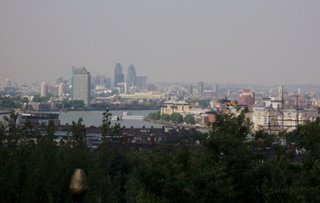 The Thames and London from the Observatory
The Thames and London from the Observatory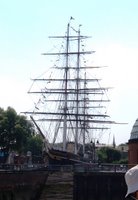
We got off at Greenwich, after traveling ont he twisting Thames. We quickly passed by the Cutty Sark, the last of the great China tea clippers and walked through a bit of town,through Greenwich Park, and up the hill to the Greenwich Observatory, located on the Prime Meridian.
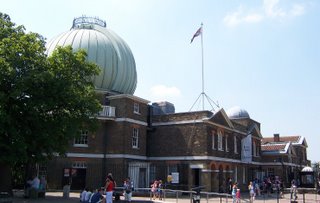
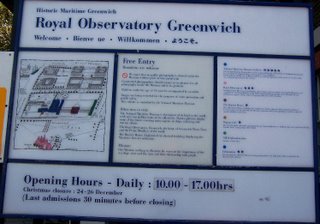
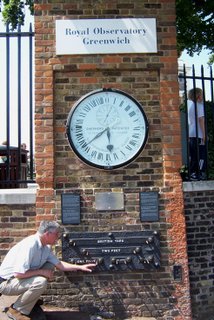
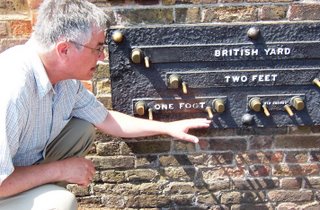
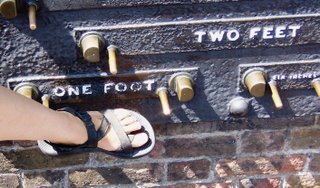
We measured our feet using the standard foot measure there, and of course stood over the Prime Meridian.
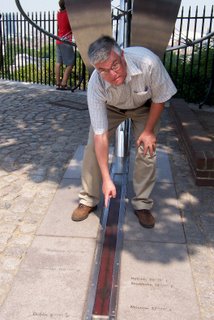
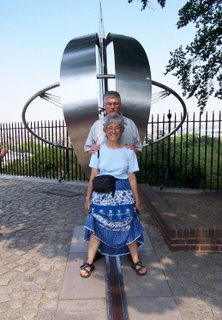
When the Observatory was begun, funding was provided for the building and salaries but not for equipment, so we saw one of the first telescropes the scientists built.
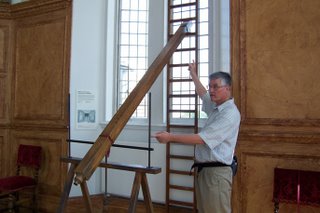
We then walked down the hill to the National Maritime Museum and spent a lot of time in the Nelson gallery. You can check it out at: http://www.nmm.ac.uk/
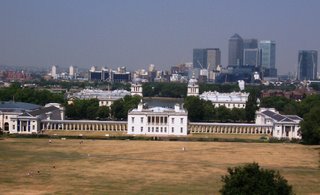
From there we walked to the adjoining building, the Queen's House, to see the painting by Turner of the Battle of Trafalgar--not an accurate representation but combined all of the significant events into one painting--something very bizarre for the people to see at that time...and me too.
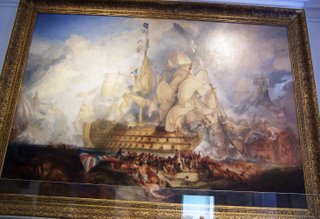
We enjoyed sitting on the way back, ate at another pub, and fell asleep early, exhausted from the day.
Day 3 started by taking the subway to King's Cross Station (ticket was 3 pounds each or about $4.80 US), of Harry Potter fame.
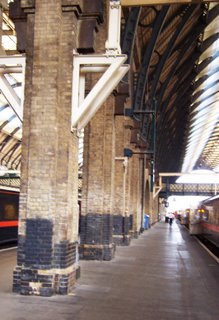
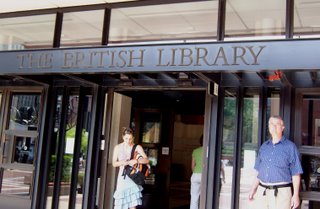
From there we walked a block to the British Library, where we spent close to two hours in the one big room with precious books, maps,and manuscripts from history. This to me was one of the highlights of our visit here. There were so many amazing items here:
Stamps from the Stamp Act of 1765
Thomas More's last letter to Henry VIII
A Greek Old Testment Picture Book of approx 1500
An illustrated Lives of the Saints form the 11th century
A draft letter of Queen Elizabeth I, after nearly dying of smallpox, in which
she refused to name a successor but might marry
The Anglo Saxon Chronicle--the earliest known history of England, done
in the late 800s and recopied in the 1040s
The Forli Siddur from Italy 1383 with Illustrations of people in it
The earliest known Christian Bible from approx 350 in Greek-- the Codex
Sinaiticus
An oriental Hebrew Bible in teh 10th century with trop of Aaron Ben Asher--
recently developed
Qur'an of the 8th century
The original Alice in Wonderland stories, written for Alice before the book was published and with the author's own illustrations
Tibetian works...one from the 8th century
One page of a Guttenberg Bible from 1454
Aesop's Fables printed in English in 1484
Beowolf--the only surviving medieval copy
Turkish book of victory 158 over Georgia...illustrated
and of course, the Magna Carta of 1215.
4 copies of the Magna Carta of 1215 are left, but only one still has the seal, and it was burnt but was saved and on display. I had forgotten the history of the Magna Carta, its issuance and its reissue ten years later and all the politics involved.
In addition, there were musical scores by Chopin, Mozart, and of Handel's Messiah...all signed by the composers and also some amazing maps, including the only surviving example of one by Mercator. We could not take pictures here either, but you can learn more about this place at http://www.bl.uk/. Howard and I shared a sandwich at the cafeterial, under the 50-foot-tall wall housing 65,000+ books of King George IV, who donated them to the people of England in 1823.
The building was very very well air-conditioned, a great place to be on a hot day. Although we could not take pictures, you can check out the items we saw at http://www.bl.uk/onlinegallery/homepage.html. Go to "Sacred Texts," "Showcases" and/or "Turning the Pages." Outside the bulding was an interesting sculpture of Newton.
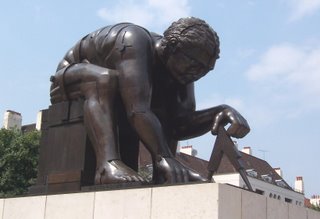
We next walked about 3/4ths mile, slightly down hill to the British Museum. On the way, we passed by many buildings of the University of London. In several places, we saw markers where famouls people had lived, including Darwin's house (which is now the Dept of Zoology).
First we went into the reading room--it had been the reading room when the British Library was there. When the library was moved a few years ago, the round reading room remained, though the higher bookshelves were removed and a dome skylight put in. Marx was among the famous people who studied there.
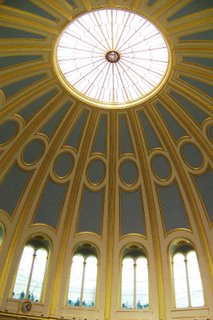

We were just settling into the Egyptian exibit area, and had seen the Rosetta stone,

when an extremely loud sound rang out. It turned out to be a fire alarm, and we were there for a very rare event...the evacuation of the building during a fire alarm. Howard was shocked that it took more than 20 minutes to evacuate the building. Then we stood in the hot sun for another hour.
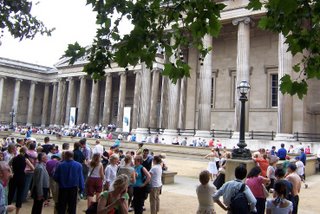
By the time we went back in, we were quite drained, but did manage to quickly see more parts of the Egyptian, Greek, Assyrian, andRoman British and Anglo-Saxon areas of the museum, but it was just too hot to stay for long. (The average high in London in July is usually 71 degrees, but the low that night was over 75 degrees--and the high in the 90s. )


Ramses II, front and back

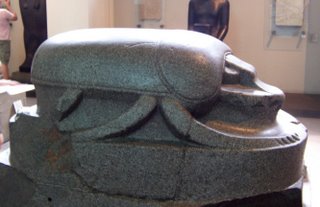
Scarab
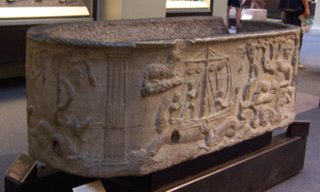 Roman Britain Sarcofacas with story of Jonah engraved on it
Roman Britain Sarcofacas with story of Jonah engraved on it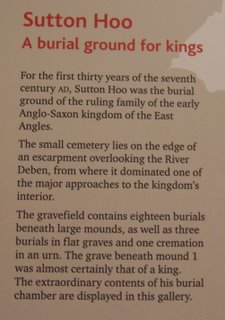
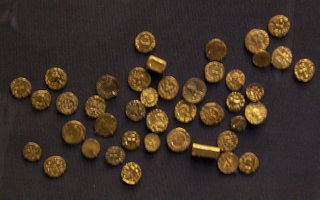
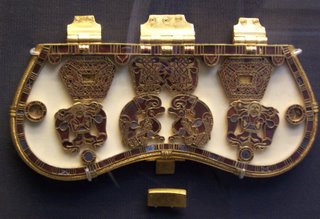
Sutton Hoo coins and purse
We stumbled into our third pub where I was treated to a great vegetarian Indian dish, all too still at a reasonable price! We walked back thrhough the Victoria Station shops, explored a book store and a grocery store, before heading home for the night.
Today was our last full day in London. We started with a tour of Westminster Abbey, the one place we paid a regular admissions fee--ten pounds for adults and 8 pounds for seniors. The building itself was astounding, begun over 940 years ago by King Edward. http://www.westminster-abbey.org/ We were not allowed to take pictures here either.
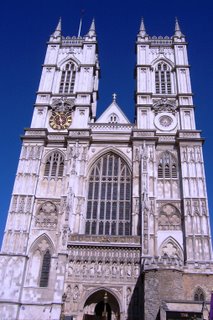
Over 3000 tombs and the remains of 29 rules are buried here. There are also hundreds of memorials to poets, politicians, church leaders, and others throughout the building. It was interesting to see that Queen Elizabeth I and his half-sister Queen Mary I, quite adeversarial in life, are burried int he same tomb with only Elizabeth's name marking it. We also saw the coronation spot and the ancient coronation chair.
Most such graves have sculptures of the person inside on the top. Queen Elizabeth I's is one of the few with her hands NOT in prayer. Her death mask is quite stunningly accurate.
Our next stop was a mile off, the Tate British Museum.(There is also a Tate Modern museum too.). It houses many many British paintings from 1500 to modern times. It has a huge collection (9 rooms) of works by Turner, the most in one museum. Howard was also suprised to see at least four Whistler paintings. Though Whistler was an American, he resettled in England and lived here a longtime.
Yes, we did go to a 4th pub for dinner, and Howard had fish and chips!
We managed to get quite a bit in during our 4 days here...and walked our feet off. It was easy to do, as the area is relatively flat and things were not too far away. All the best, Dina and Howard
